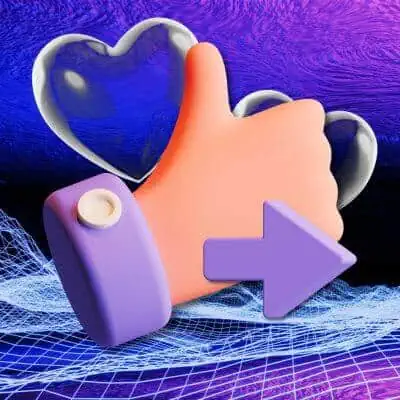To swipe or not to swipe…that is the question. Ok, so it’s not the exact Shakespearean quote, but a little creative license is pertinent and relevant regarding dating apps.
Because in the olden days, a nod, smile, sneer, or handshake was the most prevalent gesture to show approval or disapproval? But that was then, and IRL and times have changed.
Now, we’re all about swiping left and swiping right. But if you’re wracking your brain wondering what these terms mean or even curious about the cultural shift behind these swipes, you’re in for a fun lesson. What does swiping left vs swiping right mean?

The Dawn of the Digital Swipe
Before we embark on the whole swiping odyssey, we need to rewind a bit. The advent of smartphones and mobile apps paved the way for tactile interaction unlike any other–soon, designers of user interfaces (UI) recognized that swiping could be an easy and intuitive way to move around apps and scroll through online content.
And then came Tinder, the groundbreaking dating app launched in 2012. Their claim to fame? It was not just simplifying online dating–oh no–it was their innovative use of swiping left and right as a means of saying “heck yes” or “uh uh, no way.”
Swipe Right: The Digital Thumbs Up
Swiping right, in its earliest and purest form on Tinder, meant one thing: “Me likey.” It’s a thumbs up, a virtual nod if you will. It shows interest, approval, and signals, “Tell me more.”
Over time, this swiping gesture extended beyond the world of online dating; think of it as giving something a virtual “sup” nod–on dating platforms like Tinder, it means you’re interested in getting to know the person.
On a job networking app like Shapr, it illustrates you’d like to connect professionally. And on many online shopping apps, swiping right often adds an item to a wishlist. It’s a “Yes, please” action across the board.


Swipe Left: Thanks, But Nah
On the flip side, the harsher one, swiping left, is the digital equivalent of saying, “Nope.” It’s a rejection, but not in a harsh, judgmental way, and it’s not face-to-face, so the people you swipe left on may eventually figure out you said “No, thank you” by way of a left swipe; you don’t have to reject them IRL. It’s more like a polite decline! The world of online interactions needed a way to say no without the awkwardness of outright rejection, and swiping left fit the bill perfectly.
Just as swiping right has its applications beyond dating, so does swiping left. It’s become a sort of universal code for ‘pass’ or ‘not interested.
Beyond The Binary: The Swipe’s Cultural Impact
The most interesting thing about swiping is its influence on pop culture and our everyday language. You know you’ve either heard someone say (or you may have said it yourself) “I’d swipe right on that!”
That a dating app gesture has made its way into casual conversations and most people understand the meaning behind the phrase is HUGE. You don’t hear people saying, “I’d tap the heart on that,” do you? No, you don’t. The significance of it making its way into the real world cannot be understated.
But like any cultural phenomenon, the swipe comes with its critics–some argue that a simple swipe simplifies complicated choices into trivial gestures. Is it fair to judge a potential partner with just a quick finger flick? That’s a legit conversation to be had about the depth or lack thereof, that swiping introduces into our decision-making processes, but that’s for another day!


The Future of Swiping
While swiping left and right has become literally ingrained in our digital dabbling, the tech world never stops evolving. Voice commands, gesture recognition, and even thought-driven interfaces are on the horizon. It begs the question: Will swipes become a relic of the past, like flip phones and CD-Roms?
Maybe, but for now, they remain an iconic part of our digital lexicon, encompassing our choices with a simple, tactile motion.
Takeaways
Among a broad range of human gestures, swiping left and right are relatively recent additions–yet, they’ve woven themselves into our digital and cultural fabric. They’re more than just motions; they reflect how we make choices in the digital day and age—quickly, intuitively, and with a little entertainment.
So, the next time you find yourself on Tinder or any other dating app that uses the swipe gesture, take a moment to appreciate the humble beginnings of the cultural-shifting actions and give a thank you to the tech behind it–the swipe is the gift that keeps on giving.
